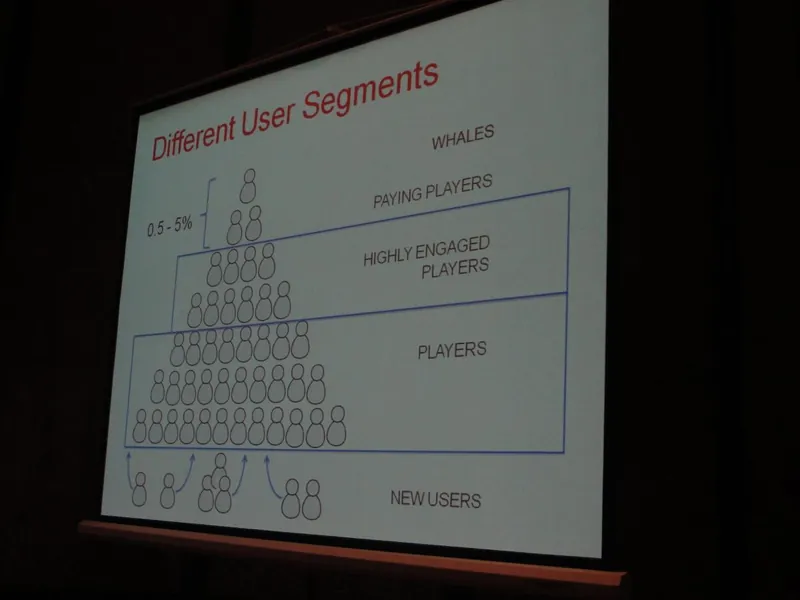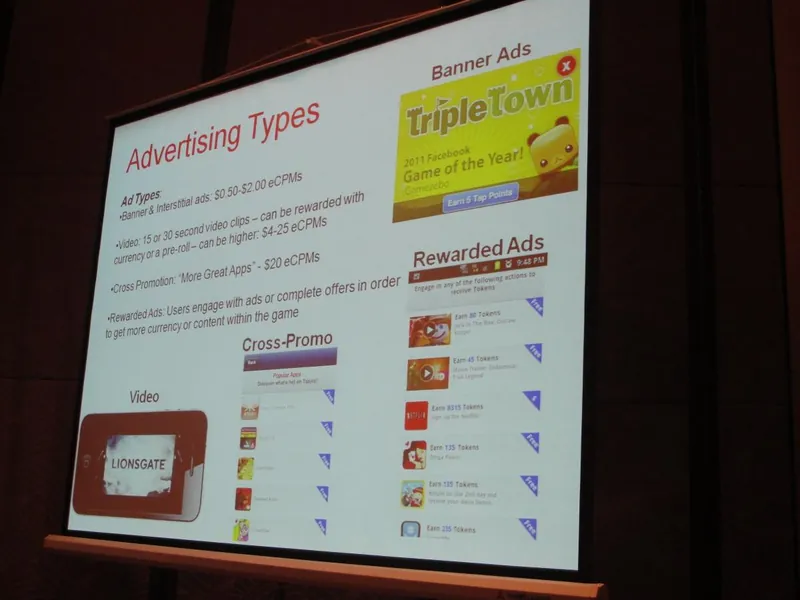
Christine Lee, VP & GM of Tapjoy, gave a talk about mobile advertising and in-app purchasing. This is the focus of Tapjoy's business model so she had plenty of case studies and data to show as well, such as the fact that 87% of the iTunes App Store as of May 2012 consisted of apps that used some form of in-app purchasing as opposed to charging money to buy the app initially. Despite the popularity of the model it requires proper use to be successful, as demonstrated by the pyramid diagram she used to show your user base:
Here you can see how a paltry 0.5 - 5% of your players are actually spending a good deal of money on your game. These are the big players in your market or the "whales" as they are referred to. Beneath them you have players that are playing your game a lot but perhaps not buying a lot. Below them are players who haven't purchased much if anything at all and below them are the new users, who you want to work their way up the funnel to the top.
Many of the in-app purchasing revolves around in-app currency. You play the game and earn points that you can spend on new features or items. You also have the option of simply paying real money to get points. TapJoy ads a third option - having players look at ads for in-game currency. If done right, these "rewarded ads" can be very successful for both the advertiser and the game developer. An example Christine gave was how Samsung placed an ad in an app (Mega Jump) that instructed people to click through to visit Samsung Mobile's Facebook page. After doing so the user would get around 200 Mega Points to spend in the game. Samsung saw over 1M visits in response.
There are more traditional ads in use for mobile apps as well, and it's important that you know how to use them to get the best effect. For example if you have an app that plays like a TV game show, it could be a great place to use a lot of interstitial video ads between rounds like a commercial break. Placing ads in your game is as much an art as it is science and Christine has a few suggestions for you:
- Balance your ad delivery: Take stock of things like the number of game sessions your user typically partakes in for a given play period. If your game is meant for short play sessions during a subway ride or standing in line, you don't want to waste too much of your player's time with ads like video interstitials. Make sure you are not showing more full-screen ads than the number of various game screens your players will see in a given play session.
- Match ads to your game content: This is what I meant with my earlier example of video ads for a game show app. It also applies to game with currency that can use the rewarded ads ad type. If your game only takes place on a single screen for the majority of its play (like Bejeweled) then banner ads could be best to fit in up top
- Target ads to users: This is tricky but can be worthwhile. Some examples Christine gave were not delivering currency ads to players who pay for a lot of their items (and vice versa) and rewarding players who play longer with less advertising interruptions.
There was plenty more data included on Christine's slides, which I have attached below.



